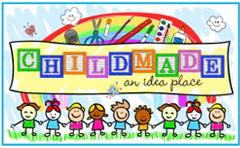
It's the first of a math themed series, set in ancient China, by Virginia Walton Pilegard.






Each of the engaging stories has a short Chinese history lesson at the back, as well as a suggestion for an easy to make, math themed, craftivity, and there are additional study guides for many of the books on the publisher's website.
 As you might imagine there is a pattern for a tangram puzzle at the back of the book we read today. Since the story is about a contest to try to put a broken tile back together into its original square shape, I thought it might be fun to cut a puzzle out for each of the children to monkey with at lunch, to see who could be the first to form the square.
As you might imagine there is a pattern for a tangram puzzle at the back of the book we read today. Since the story is about a contest to try to put a broken tile back together into its original square shape, I thought it might be fun to cut a puzzle out for each of the children to monkey with at lunch, to see who could be the first to form the square.
The children are familiar with tangrams, but usually we use them to make various shapes, and pictures. It's not too often, that we remake the original square. A (age 10) solved the problem by flipping to the back of the book, and looking at the pattern there.
I told her that was cheating, and then happily played the audio version of Barbara Park's Junie B., First Grader: Cheater Pants...

...which I had downloaded from our library's online catalogue last night, after reading the suggestion from publisher's study guide for The Warlord's Puzzle to introduce children to cinquains (5 line poems, pronounced sing-cane, as a combination of the French words cinq, for five, and quatrain, for four lined poem, made popular by American poet Adelaide Crapsey in early 1900s as a nod to the haiku), which somehow reminded the author of the love of nature shown by Chinese poets in their writing.
It just so happens that Junie B., First Grader: Cheater Pants, in addition to addressing and defining the problem of cheating, also has a very clearly spelled out lesson on cinquains for children.
1st line: One word (title)
2nd line: Two words that describe the title
3rd line: Three action words about the title
4th line: Four words that express a thought or feeling about the title
5th line: One word that means the same thing as the title.
Which, is how we ended up spending our morning, and part of the afternoon working Chinese puzzles while creating silly little American, French named, Japanese inspired poems.
It's great to be a homeschooler.




6 comments:
This is brilliant. I might try it with Anna and her best friend. I doubt they will be able to whip up a square though - I only learned how to do it in my twenties :)
What an interesting book series!
Those books are on my list of things to do...now you have really motivated me to push them up the list! :)
I still struggle with making that square sometimes. Isn't that silly?
Sounds like tons of fun. Our library did not have any of these books but the first is coming through interlibrary loan. I can't wait to try it with Froggy.
I just found your blog and I love it! We are so close to being home schoolers as well and there is so much inspiration for me here! Love it! Thank you! Thank you! Can't wait to browse more!
Post a Comment